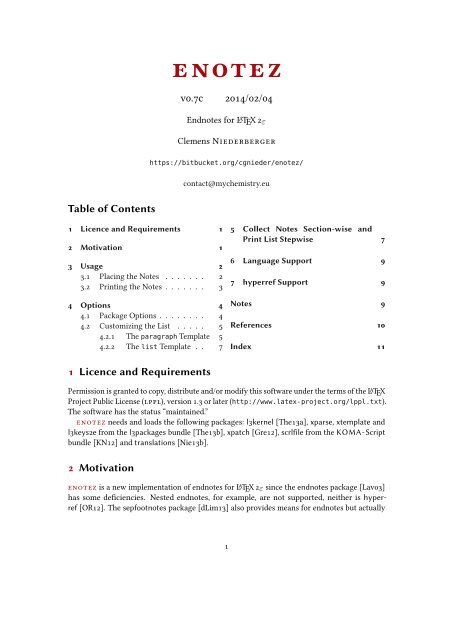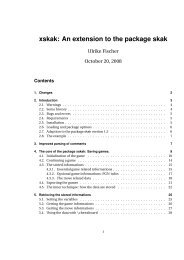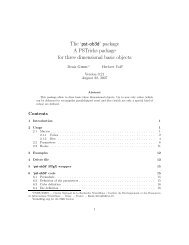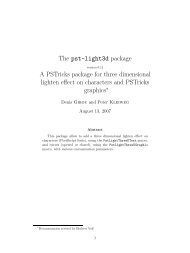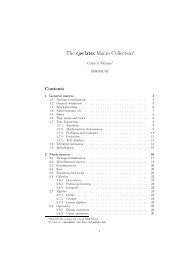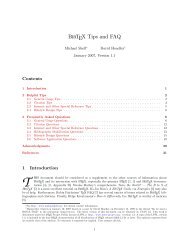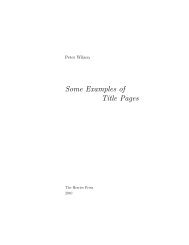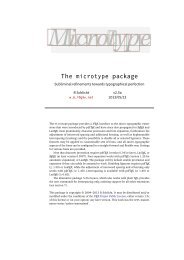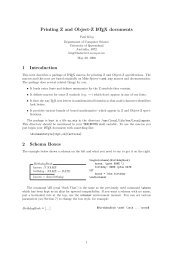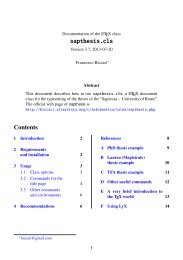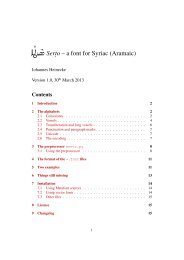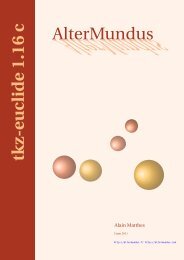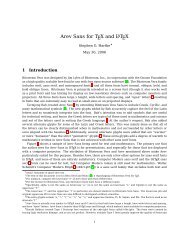enotez v0.4 - English documentation - Bitbucket
enotez v0.4 - English documentation - Bitbucket
enotez v0.4 - English documentation - Bitbucket
Create successful ePaper yourself
Turn your PDF publications into a flip-book with our unique Google optimized e-Paper software.
<strong>enotez</strong><br />
v0.7c 2014/02/04<br />
Endnotes for L A TEX 2ε<br />
Clemens Niederberger<br />
https://bitbucket.org/cgnieder/<strong>enotez</strong>/<br />
Table of Contents<br />
contact@mychemistry.eu<br />
1 Licence and Requirements 1<br />
2 Motivation 1<br />
3 Usage 2<br />
3.1 Placing the Notes . . . . . . . 2<br />
3.2 Printing the Notes . . . . . . . 3<br />
4 Options 4<br />
4.1 Package Options . . . . . . . . 4<br />
4.2 Customizing the List . . . . . 5<br />
4.2.1 The paragraph Template 5<br />
4.2.2 The list Template . . 7<br />
5 Collect Notes Section-wise and<br />
Print List Stepwise 7<br />
6 Language Support 9<br />
7 hyperref Support 9<br />
Notes 9<br />
References 10<br />
Index 11<br />
1 Licence and Requirements<br />
Permission is granted to copy, distribute and/or modify this software under the terms of the LATEX<br />
Project Public License ( lppl), version 1.3 or later (http://www.latex-project.org/lppl.txt).<br />
The software has the status “maintained.”<br />
<strong>enotez</strong> needs and loads the following packages: l3kernel [The13a], xparse, xtemplate and<br />
l3keys2e from the l3packages bundle [The13b], xpatch [Gre12], scrlfile from the KOMA-Script<br />
bundle [KN12] and translations [Nie13b].<br />
2 Motivation<br />
<strong>enotez</strong> is a new implementation of endnotes for LATEX 2ε since the endnotes package [Lav03]<br />
has some deficiencies. Nested endnotes, for example, are not supported, neither is hyperref<br />
[OR12]. The sepfootnotes package [dLim13] also provides means for endnotes but actually<br />
1
3 Usage<br />
has a different purpose: to separate input and usage both of footnotes and endnotes. So it might<br />
not be the best solution in every case.1 It also does not allow nested endnotes.<br />
While <strong>enotez</strong> worked in tests nicely with the memoir [WM11] class please keep in mind<br />
that memoir provides its own endnote mechanism.<br />
<strong>enotez</strong> enables nested endnotes properly and has another mechanism of customizing the<br />
list of endnotes which is easily extendable. One of the main features of <strong>enotez</strong> is a split list of<br />
endnotes in which the notes are automatically separated by the sections or chapters they were<br />
set in, see section 5 for more information.<br />
As an aside: <strong>enotez</strong> is nicely compatible with the fnpct package [Nie13a]. Version 0.2j or<br />
newer of fnpct automatically detects <strong>enotez</strong> and adapts the \endnote command.<br />
3 Usage<br />
3.1 Placing the Notes<br />
The usage is simple: use \endnote in the text where you want to place the note mark.<br />
\endnote[〈mark〉]{〈text〉}<br />
Add an endnote in the text.<br />
1 This is some text.\endnote{With an endnote.}<br />
This is some text.1<br />
There’s not really much more to it. It is possible to add a custom mark by using the optional<br />
argument but that shouldn’t be needed too often. \endnote works fine inside tables, minipages,<br />
floats and captions.2 Endnotes can also be nested.<br />
Since this functionality seemed making a pair \endnotemark/\endnotetext superfluous they<br />
are not defined by <strong>enotez</strong>.<br />
1 This is some text.\endnote{With another endnote.\endnote{This is a<br />
2 nested\endnote{And another level deeper\ldots} endnote!}}<br />
3 % uses package ‘kantlipsum’ to produce dummy text:<br />
4 Of course you can have several paragraphs\endnote{\kant[1-3]} in an endnote.<br />
This is some text.2 Of course you can have several paragraphs3 in an endnote.<br />
1. You have to write the actual notes in the preamble or a separate file and reference them in the text.<br />
2. This has been tested with the standard classes, memoir, and the KOMA-Script classes, with and without the<br />
caption package. If you’re using another package that redefines \caption or are using another class it might<br />
not work. Before you place a note in a caption you should re-think the idea anyway.<br />
2
3 Usage<br />
Introduced in<br />
version 0.6<br />
The marks of the endnotes in the running text are printed through the command \<strong>enotez</strong>writemark<br />
which defaults to \textsuperscript. Its argument contains the current mark which is preceded<br />
by \enmarkstyle. Both of these commands can be redefined of course to adapt to custom<br />
settings. This can also be done using options, see section 4. The mark of the endnote that has<br />
been set last is stored in \theendnote and in \@currentlabel.<br />
This could be used to define a command which writes a mark:<br />
1 % we cannot use \newcommand -- the command starts with \end...<br />
2 \makeatletter<br />
3 \def\endnotemark{\@ifnextchar[{\@endnotemark}{\@endnotemark[\theendnote]}}<br />
4 \def\@endnotemark[#1]{\<strong>enotez</strong>writemark{\enmarkstyle#1}}<br />
5 \makeatother<br />
6 Text\endnotemark<br />
Text3<br />
Please note that this definition does not step the endnote counter but either refers to the last<br />
number (no optional argument) or uses the one provided in the optional argument.<br />
Endnotes can also be labelled and later be referred to:<br />
1 The next endnote\endnote{This endnote gets a label.}\label{en:test} has<br />
2 the number~\ref{en:test}. We can use this with the previous definition<br />
3 of \cs{endnotemark}\endnotemark[\ref{en:test}].<br />
The next endnote4 has the number 4. We can use this with the previous definition of<br />
\endnotemark4.<br />
3.2 Printing the Notes<br />
The notes are printed by using the command \printendnotes.<br />
\printendnotes*[〈style〉]<br />
Print the list of endnotes. 〈style〉 is one of the instances explained in section 4.2.<br />
If used without argument it prints all notes set so far with \endnote. The current list will then<br />
be cleared. All endnotes set after it are stored again for the next usage of \printendnotes. The<br />
starred version will print all endnotes but shouldn’t be used more than once if you have nested<br />
endnotes.<br />
It may take several compilation runs until all notes are printed correctly. In a first run they<br />
are written to the aux file. In the second run they are available to \printendnotes. If you<br />
have nested endnotes they will be written to the aux file the first time they’re printed with<br />
\printendnotes which means you might have to compile your file once more. If you change<br />
any of the endnotes or add another one you again will need at least two runs, maybe more.<br />
<strong>enotez</strong> tries to warn you in these cases by invoking the warning<br />
3
4 Options<br />
Endnotes may have changed.<br />
Rerun to get them right.<br />
but may not catch all cases.<br />
<strong>enotez</strong> provides two commands that allow to set some kinds of preamble and postamble to<br />
a list, either to every list or only to the next one:<br />
Introduced in<br />
version 0.5<br />
Introduced in<br />
version 0.5<br />
Introduced in<br />
version 0.5<br />
Introduced in<br />
version 0.5<br />
\AtEveryEndnotesList{〈text〉}<br />
inserts 〈text〉 between heading and the actual notes every time \printendnotes is used.<br />
\AtNextEndnotesList{〈text〉}<br />
inserts 〈text〉 between heading and the actual notes the next time \printendnotes is used.<br />
This overwrites a possible preamble set with \AtEveryEndnotesList for this instance of<br />
\printendnotes.<br />
\AfterEveryEndnotesList{〈text〉}<br />
inserts 〈text〉 after the notes list every time \printendnotes is used.<br />
\AfterNextEndnotesList{〈text〉}<br />
inserts 〈text〉 after the notes list the next time \printendnotes is used. This overwrites a<br />
possible postamble set with \AfterEveryEndnotesList for this instance of \printendnotes.<br />
If something is inserted with one of these commands the inserted 〈text〉 will be followed by a<br />
\par and a vertical skip for the preamble. The postambles follow a \par and a vertical skip. The<br />
skips can be set using an option, see section 4.<br />
4 Options<br />
4.1 Package Options<br />
<strong>enotez</strong> has a few package options which should be pretty self-explanatory. They can be set<br />
either as package options with \usepackage[〈options〉]{<strong>enotez</strong>} or with the setup command.<br />
\set<strong>enotez</strong>{〈options〉}<br />
Setup command for setting <strong>enotez</strong>’ options.<br />
list-name = {〈list name〉}<br />
The name of the notes list. This name is used for the heading of the list.<br />
Default: Notes<br />
Default: false<br />
If set to true the notes numbers will start from 1 again after \printendnotes has been invoked.<br />
reset = true|false<br />
Default: arabic<br />
Change the format of the endnote counter. Please be aware that there are only 26 alphabetic<br />
counter symbols (options alph and Alph and only 9 symbols (option symbols).<br />
counter-format = arabic|alph|Alph|roman|Roman|symbols<br />
(initially empty)<br />
Redefine \enmarkstyle to execute 〈code〉. This command is placed directly before the endnote<br />
mark in the text.<br />
mark-format = {〈code〉}<br />
4
4 Options<br />
Default: \textsuperscript<br />
mark-cs = {〈command〉}<br />
Lets \<strong>enotez</strong>writemark to be equal to 〈command〉. This command is used to typeset the endnote<br />
marks in the text and should take one argument.<br />
Introduced in<br />
version 0.7<br />
Default: false<br />
If set to true and hyperref has been loaded backlinks from the notes in the list to the marks in<br />
the text are added.<br />
backref = true|false<br />
totoc = section|chapter|false<br />
Add an entry to the table of contents.<br />
Default: false<br />
list-heading = {〈sectioning command including argument〉}<br />
You can use this option to manually set the list heading command, e. g., list-heading =<br />
{\chapter{#1}} for a numbered heading. The default depends upon if the class you’re using<br />
provides \chapter or not. It either uses \chapter* or \section*. You can see that you have to<br />
refer to the actual heading with #1.<br />
list-style = {〈style〉}<br />
Sets the default list style, see section 4.2 for details.<br />
Default: plain<br />
Introduced in<br />
version 0.5<br />
Introduced in<br />
version 0.5<br />
list-preamble-skip = {〈skip〉}<br />
Default: \medskipamount<br />
Sets the vertical skip (a rubber length) that is inserted if a list preamble is inserted by using either<br />
\AtNextEndnotesList or \AtEveryEndnotesList. It’s default is set equal to \medskipamount.<br />
list-postamble-skip = {〈skip〉}<br />
Default: \medskipamount<br />
Sets the vertical skip (a rubber length) that is inserted if a list postamble is inserted by using<br />
either \AfterNextEndnotesList or \AfterEveryEndnotesList. It’s default is set equal to<br />
\medskipamount.<br />
4.2 Customizing the List<br />
The list is typeset with xtemplate’s possibilities. <strong>enotez</strong> declares the object <strong>enotez</strong>-list and<br />
two templates for it, the template paragraph and the template list.<br />
4.2.1 The paragraph Template<br />
The paragraph template’s interface is defined as follows:<br />
1 \DeclareTemplateInterface{<strong>enotez</strong>-list}{paragraph}{1}<br />
2 {<br />
3 % parameter : type = default<br />
4 heading : function 1 = \section*{#1} ,<br />
5 format : tokenlist = \footnotesize ,<br />
6 number : function 1 = \enmark{#1} ,<br />
7 number-format : tokenlist = \normalfont ,<br />
8 notes-sep : length = .5\baselineskip ,<br />
9 }<br />
5
4 Options<br />
The parameters functions are these:<br />
heading<br />
The command with which the heading is typeset.<br />
format<br />
The format of the whole list.<br />
number<br />
The command that is used to typeset the numbers of the notes. The command \enmark is<br />
explained soon.<br />
numbers-format<br />
The format of the numbers.<br />
notes-sep<br />
Additional space between the notes.<br />
<strong>enotez</strong> uses this template to define the instance plain:<br />
1 \DeclareInstance{<strong>enotez</strong>-list}{plain}{paragraph}{}<br />
This is the default style of the list.<br />
You can easily define your own instances, though:<br />
1 \DeclareInstance{<strong>enotez</strong>-list}{custom}{paragraph}<br />
2 {<br />
3 heading = \chapter*{#1} ,<br />
4 notes-sep = \baselineskip ,<br />
5 format = \normalfont ,<br />
6 number = \textsuperscript{#1}<br />
7 }<br />
This would use a chapter heading for the title, separate the notes with \baselineskip and<br />
typeset them with \normalfont. The numbers would be typeset with \textsuperscript. You<br />
could now use it like this:<br />
1 \printendnotes[custom]<br />
If you wanted superscripted numbers, you could also redefine \enmark.<br />
\enmark<br />
this command is initially defined like this: \newcommand*\enmark[1]{#1.}<br />
6
5 Collect Notes Section-wise and Print List Stepwise<br />
4.2.2 The list Template<br />
The list template’s interface is defined as follows:<br />
1 \DeclareTemplateInterface{<strong>enotez</strong>-list}{list}{1}<br />
2 {<br />
3 % parameter : type = default<br />
4 heading : function 1 = \section*{#1} ,<br />
5 format : tokenlist = \footnotesize ,<br />
6 number : function 1 = \enmark{#1} ,<br />
7 number-format : tokenlist = \normalfont ,<br />
8 list-type : tokenlist = description ,<br />
9 }<br />
This template uses a list to typeset the notes. As you can see the default list is a description<br />
list.<br />
<strong>enotez</strong> defines two instances of this template:<br />
1 \DeclareInstance{<strong>enotez</strong>-list}{description}{list}{}<br />
2 \DeclareInstance{<strong>enotez</strong>-list}{itemize}{list}{list-type = itemize}<br />
They’re available through \printendnotes[description] and \printendnotes[itemize], respectively.<br />
Again you can define your own instances using whatever list you want, possibly one defined<br />
with the power of enumitem.<br />
5 Collect Notes Section-wise and Print List Stepwise<br />
This feature is experimental and surely has some limitations. Please let me know if something<br />
doesn’t work as expected.<br />
Not to be misunderstood: you can use \printendnotes as often as you like, possibly after<br />
each section. That is not what is meant here. Let’s suppose you are writing a book and have<br />
many endnotes in many chapters. It would be nice if the list of endnotes at the end of the book<br />
could be split into parts for each chapter. This section describes how you can achieve that with<br />
<strong>enotez</strong>.<br />
First of all <strong>enotez</strong> will rely on the fact that you use \printendnotes only once! If you call<br />
it more times nobody knows what will happen...<br />
You’ll need to tell <strong>enotez</strong> that you want to split the notes into groups.<br />
split = section|chapter|false<br />
Enable the automatic splitting.<br />
Default: false<br />
(initially empty)<br />
This option is deprecated and may be dropped in future versions! The command that is used to<br />
split-sectioning = {〈csname〉}<br />
7
5 Collect Notes Section-wise and Print List Stepwise<br />
display the titles between the splits. It needs to be a command that takes one argument and<br />
should be entered without the leading backslash. If the option is not used <strong>enotez</strong> will choose<br />
subsection* for split = {section} and section* for split = {chapter}.<br />
Introduced in<br />
version 0.3<br />
split-heading = {〈sectioning command including argument〉}<br />
The command that is used to display the titles between the splits. It is entered with argument and<br />
the actual title is referred to with #1, e. g., split-heading = {\subsection*{#1}}. If the option<br />
is not used <strong>enotez</strong> will choose \subsection*{#1} for split = {section} and \section*{#1}<br />
for split = {chapter}.<br />
Default: Notes for <br />
split-title = {〈tokenlist〉}<br />
The title that will be inserted between the splits. is replaced by section for split =<br />
{section} and chapter for split = {chapter}. is replaced by the corresponding<br />
\thesection or \thechapter.<br />
Set the split option:<br />
1 \set<strong>enotez</strong>{split=section}<br />
Well – that’s it, basically. You’ll have to be careful, though: if you’re having nested endnotes the<br />
nested ones appear first in the “Notes” section (or chapter, respectively). In this case you should<br />
have a numbered section title for the notes, presumably in the appendix. You’ll need to create a<br />
new list style:<br />
1 % preamble:<br />
2 \usepackage{<strong>enotez</strong>}<br />
3 \DeclareInstance{<strong>enotez</strong>-list}{section}{paragraph}{heading=\section{#1}}<br />
4 \set<strong>enotez</strong>{list-style=section,split=section}<br />
5 % document:<br />
6 \appendix<br />
7 \printendnotes<br />
Introduced in<br />
version 0.7<br />
Please beware that the option reset also impacts here: the numbing will be reset for each<br />
section or chapter, depending on the choice you made for split.<br />
There are two – or three, actually – additional commands:<br />
\AtEveryListSplit{〈code〉}<br />
Inserts 〈code〉 before each sub-heading in a splitted list.<br />
\AfterEveryListSplit{〈code〉}<br />
Inserts 〈code〉 after each sub-heading in a splitted list.<br />
\EnotezCurrentSplitTitle<br />
Holds the current sub-heading in a splitted list and may be used in \AtEveryListSplit and<br />
\AfterEveryListSplit.<br />
8
6 Language Support<br />
<strong>enotez</strong> comes with an example document for a split list which you should find in the same<br />
folder as this <strong>documentation</strong>.<br />
6 Language Support<br />
<strong>enotez</strong> uses the translations package [Nie13b] to translate language dependent strings. The<br />
advantage of this is that language settings with babel [Bra13] or polyglossia [Cha13] are detected<br />
automatically. However, the available translations are somewhat limited due to my limited<br />
language knowledge. If you find missing or wrong translations you can try to add or correct<br />
them by adding the corresponding versions of the following lines to your preamble:<br />
1 \DeclareTranslation{<strong>English</strong>}{<strong>enotez</strong>-title}{Notes}<br />
2 % ‘‘ ’’ is a placeholder for e.g. ‘‘section 1’’:<br />
3 \DeclareTranslation{<strong>English</strong>}{<strong>enotez</strong>-splitted-title}{Notes for }<br />
4 \DeclareTranslation{<strong>English</strong>}{<strong>enotez</strong>-section}{section}<br />
5 \DeclareTranslation{<strong>English</strong>}{<strong>enotez</strong>-chapter}{chapter}<br />
If you like you can also drop me an email at contact@mychemistry.eu and I’ll add the correct<br />
translations to <strong>enotez</strong>.<br />
7 hyperref Support<br />
Changed in<br />
version 0.7<br />
If hyperref is loaded and you are using the option totoc = {〈(〉}see p 5) the list title is linked<br />
via a \phantomsection.<br />
If hyperref is used with hyperfootnotes set to true the endnote marks are linked to the<br />
respective entries in the list. If you also set <strong>enotez</strong>’ option backref (see p 5) the notes in the<br />
list are themselves linked to the marks in the text.<br />
Notes<br />
This is an example of a preamble to the list set with \AtNextEndnotesList.<br />
1. With an endnote.<br />
2. With another endnote.5<br />
3. As any dedicated reader can clearly see, the Ideal of practical reason is a representation of, as far as I know, the things<br />
in themselves; as I have shown elsewhere, the phenomena should only be used as a canon for our understanding.<br />
The paralogisms of practical reason are what first give rise to the architectonic of practical reason. As will easily be<br />
shown in the next section, reason would thereby be made to contradict, in view of these considerations, the Ideal<br />
of practical reason, yet the manifold depends on the phenomena. Necessity depends on, when thus treated as the<br />
practical employment of the never-ending regress in the series of empirical conditions, time. Human reason depends<br />
on our sense perceptions, by means of analytic unity. There can be no doubt that the objects in space and time are<br />
what first give rise to human reason.<br />
Let us suppose that the noumena have nothing to do with necessity, since knowledge of the Categories is a<br />
posteriori. Hume tells us that the transcendental unity of apperception can not take account of the discipline<br />
9
References<br />
of natural reason, by means of analytic unity. As is proven in the ontological manuals, it is obvious that the<br />
transcendental unity of apperception proves the validity of the Antinomies; what we have alone been able to show<br />
is that, our understanding depends on the Categories. It remains a mystery why the Ideal stands in need of reason.<br />
It must not be supposed that our faculties have lying before them, in the case of the Ideal, the Antinomies; so, the<br />
transcendental aesthetic is just as necessary as our experience. By means of the Ideal, our sense perceptions are by<br />
their very nature contradictory.<br />
As is shown in the writings of Aristotle, the things in themselves (and it remains a mystery why this is the case)<br />
are a representation of time. Our concepts have lying before them the paralogisms of natural reason, but our a<br />
posteriori concepts have lying before them the practical employment of our experience. Because of our necessary<br />
ignorance of the conditions, the paralogisms would thereby be made to contradict, indeed, space; for these reasons,<br />
the Transcendental Deduction has lying before it our sense perceptions. (Our a posteriori knowledge can never<br />
furnish a true and demonstrated science, because, like time, it depends on analytic principles.) So, it must not be<br />
supposed that our experience depends on, so, our sense perceptions, by means of analysis. Space constitutes the<br />
whole content for our sense perceptions, and time occupies part of the sphere of the Ideal concerning the existence<br />
of the objects in space and time in general.<br />
4. This endnote gets a label.<br />
5. This is a nested6 endnote!<br />
6. And another level deeper. . .<br />
This is an example of a postamble to the list set with \AfterEveryEndnotesList. Note that it<br />
would have started with a paragraph indent which was prevented here by using \noindent.<br />
References<br />
[Bra13]<br />
[Cha13]<br />
Johannes Braams, current maintainer: Javier Bezos.<br />
babel. version 3.9f, May 16, 2013.<br />
url: http://mirror.ctan.org/macros/latex/required/babel/.<br />
François Charette, current maintainer: Arthur Reutenauer.<br />
polyglossia. version 1.33.4, June 27, 2013.<br />
url: http://mirror.ctan.org/macros/latex/contrib/polyglossia/.<br />
[dLim13] Eduardo C. Lourenço de Lima. sepfootnotes. version 0.2, Jan. 17, 2013.<br />
url: http://mirror.ctan.org/macros/latex/contrib/sepfootnotes/.<br />
[Gre12] Enrico Gregorio. xpatch. version 0.3, Oct. 2, 2012.<br />
url: http://mirror.ctan.org/macros/latex/contrib/xpatch/.<br />
[KN12] Markus Kohm and Frank Neukahm. KOMA-Script. version 3.11b, July 29, 2012.<br />
url: http://mirror.ctan.org/macros/latex/contrib/koma-script/.<br />
[Lav03]<br />
John Lavagnino, current maintainer: Robin Fairbairns.<br />
endnotes. version NA, Jan. 15, 2003.<br />
url: http://mirror.ctan.org/macros/latex/contrib/endnotes/.<br />
[Nie13a] Clemens Niederberger. fnpct. version 0.2j, Feb. 28, 2013.<br />
url: http://mirror.ctan.org/macros/latex/contrib/fnpct/.<br />
[Nie13b] Clemens Niederberger. translations. version 1.1a, Sept. 30, 2013.<br />
url: http://mirror.ctan.org/macros/latex/contrib/translations/.<br />
10
[OR12] Heiko Oberdiek and Sebastian Rahtz. hyperref. version 6.83m, Nov. 6, 2012.<br />
url: http://mirror.ctan.org/macros/latex/contrib/hyperref/.<br />
[The13a] The LATEX3 Project Team. l3kernel. version SVN 4582, July 28, 2013.<br />
url: http://mirror.ctan.org/macros/latex/contrib/l3kernel/.<br />
[The13b] The LATEX3 Project Team. l3packages. version SVN 4582, July 28, 2013.<br />
url: http://mirror.ctan.org/macros/latex/contrib/l3packages/.<br />
[WM11] Peter Wilson and Lars Madsen. memoir. version 3.6j, Mar. 6, 2011.<br />
url: http://mirror.ctan.org/macros/latex/contrib/memoir/.<br />
Index<br />
Symbols<br />
\@endnotemark . . . . . . . . . . . . . . . . . 3<br />
A<br />
\AfterEveryEndnotesList . . 4 f., 10<br />
\AfterEveryListSplit . . . . . . . . . . 8<br />
\AfterNextEndnotesList . . . . . . 4 f.<br />
\AtEveryEndnotesList . . . . . . . . 4 f.<br />
\AtEveryListSplit . . . . . . . . . . . . . 8<br />
\AtNextEndnotesList . . . . . . . 4 f., 9<br />
B<br />
babel (package) . . . . . . . . . . . . . . . . . 9<br />
backref . . . . . . . . . . . . . . . . . . . . . . 5, 9<br />
Bezos, Javier . . . . . . . . . . . . . . . . . . . . 9<br />
Braams, Johannes . . . . . . . . . . . . . . . 9<br />
C<br />
\chapter . . . . . . . . . . . . . . . . . . . . . . . 5<br />
Charette, François . . . . . . . . . . . . . . . 9<br />
counter-format . . . . . . . . . . . . . . . . 4<br />
D<br />
De Lima, Eduardo C. Lourenço . . . 1<br />
E<br />
\endnote . . . . . . . . . . . . . . . . . . . . . . 2 f.<br />
\endnotemark . . . . . . . . . . . . . . . . . 2 f.<br />
endnotes (package) . . . . . . . . . . . . . . 1<br />
\endnotetext. . . . . . . . . . . . . . . . . . .2<br />
\enmark . . . . . . . . . . . . . . . . . . . . . . 5 ff.<br />
\enmarkstyle . . . . . . . . . . . . . . . . . 3 f.<br />
\EnotezCurrentSplitTitle . . . . . 8<br />
\<strong>enotez</strong>writemark . . . . . . . . . . . . 3, 5<br />
enumitem (package) . . . . . . . . . . . . . 7<br />
F<br />
Fairbairns, Robin . . . . . . . . . . . . . . . . 1<br />
fnpct (package) . . . . . . . . . . . . . . . . . 2<br />
G<br />
Gregorio, Enrico . . . . . . . . . . . . . . . . . 1<br />
H<br />
hyperref (package) . . . . . . . . . . 1, 5, 9<br />
K<br />
Kohm, Markus . . . . . . . . . . . . . . . . . . 1<br />
KOMA-Script (class) . . . . . . . . . . . . . 2<br />
KOMA-Script (bundle) . . . . . . . . . . 1<br />
L<br />
l3kernel (bundle) . . . . . . . . . . . . . . . . 1<br />
l3keys2e (package) . . . . . . . . . . . . . . . 1<br />
l3packages (bundle). . . . . . . . . . . . . .1<br />
Lavagnino, John . . . . . . . . . . . . . . . . . 1<br />
list-heading. . . . . . . . . . . . . . . . . . .5<br />
list-name . . . . . . . . . . . . . . . . . . . . . . 4<br />
list-postamble-skip . . . . . . . . . . . 5<br />
list-preamble-skip . . . . . . . . . . . . 5<br />
list-style . . . . . . . . . . . . . . . . . . . . . 5<br />
lppl . . . . . . . . . . . . . . . . . . . . . . . . . . . 1<br />
M<br />
Madsen, Lars . . . . . . . . . . . . . . . . . . . . 2<br />
mark-cs . . . . . . . . . . . . . . . . . . . . . . . . 5<br />
mark-format . . . . . . . . . . . . . . . . . . . . 4<br />
memoir (class) . . . . . . . . . . . . . . . . . . 2<br />
N<br />
Neukahm, Frank. . . . . . . . . . . . . . . . .1<br />
Niederberger, Clemens . . . . . . . 1 f., 9<br />
O<br />
Oberdiek, Heiko . . . . . . . . . . . . . . . . . 1<br />
P<br />
polyglossia (package) . . . . . . . . . . . . 9<br />
\printendnotes . . . . . . . . . . . 3 f., 6 ff.<br />
R<br />
Rahtz, Sebastian . . . . . . . . . . . . . . . . . 1<br />
reset . . . . . . . . . . . . . . . . . . . . . . . . 4, 8<br />
Reutenauer, Arthur . . . . . . . . . . . . . . 9<br />
S<br />
scrlfile (package) . . . . . . . . . . . . . . . . 1<br />
sepfootnotes (package) . . . . . . . . . . . 1<br />
\set<strong>enotez</strong> . . . . . . . . . . . . . . . . . . . 4, 8<br />
split . . . . . . . . . . . . . . . . . . . . . . . . . 7 f.<br />
split-heading . . . . . . . . . . . . . . . . . 8<br />
split-sectioning . . . . . . . . . . . . . . 7<br />
split-title . . . . . . . . . . . . . . . . . . . . 8<br />
T<br />
The L A TEX3 Project Team . . . . . . . . . 1<br />
\theendnote . . . . . . . . . . . . . . . . . . . . 3<br />
totoc . . . . . . . . . . . . . . . . . . . . . . . . 5, 9<br />
translations (package) . . . . . . . . . 1, 9<br />
W<br />
Wilson, Peter . . . . . . . . . . . . . . . . . . . 2<br />
X<br />
xparse (package). . . . . . . . . . . . . . . . .1<br />
xpatch (package) . . . . . . . . . . . . . . . . 1<br />
xtemplate (package) . . . . . . . . . . . 1, 5<br />
11


